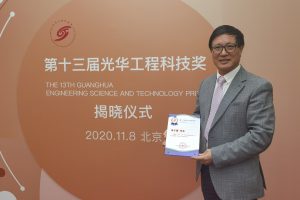Tang Zikang, chair professor and director of the Institute of Applied Physics and Materials Engineering (IAPME) at the University of Macau (UM), has received the 13th Guanghua Engineering Science and Technology Prize from the Chinese Academy of Engineering (CAE). Prof Tang is the only scholar from Macao to receive this award.
Established by the CAE in 1996, Guanghua Engineering Science and Technology Prize is regarded as the most prestigious award in the field of engineering in China. It aims to recognise outstanding Chinese scientists who have made significant contributions to the fields of engineering technology and engineering management. This year, out of the 296 nominees, 40 individuals were selected to receive the award. The recipients include nuclear power expert Peng Shilu of the CAE, mechanical engineering expert Jiang Zhuangde, metrology expert Li Tianchu, artificial intelligence expert Wang Haifeng, and special functional metal material expert Zhou Shaoxiong. In addition, a new category, Special Contribution Award, was launched this year, to recognise all members of the CAE’s Division of Medicine and Health who have made significant contributions during the fight against the pandemic. Prof Tang was nominated by the Science and Technology Development Fund of Macao SAR, and received the award after several rounds of stringent review and evaluation by CAE members and experts in related fields. The award ceremony was held recently in Beijing at the CAE’s Academician Conference.
Prof Tang is an internationally renowned leader in the field of nano-optoelectronic materials, with significant contributions to the development of nanomaterials and optoelectronic technologies as well as their applications. He discovered room-temperature ultraviolet (UV) lasing using nano-structured zinc oxide (ZnO) thin film, which generated worldwide interest in ZnO research. In 1998, he published this study in the Applied Physics Letter, which captured the attention of scientists from around the world. In 2003, he received the National Natural Science Award for this study. In 2012, the same paper was ranked among the 50 most cited papers published in the Applied Physics Letter in 50 years in its 50th anniversary edition. It was the only paper from the Greater China region to make the list.
In 2000, Prof Tang successfully fabricated the world’s smallest single-walled carbon nanotubes (SWNT) with a diameter of 0.4 nm. The study was later published in the top international journal Nature. In 2000, it was selected as one of the top ten international scientific and technological advances by the Chinese Academy of Sciences and the Chinese Academy of Engineering. Prof Tang also observed novel one-dimensional superconductivity in these ultra-small SWNTs and published this discovery in Science, creating a great deal of excitement in the international scientific community over the discovery of an ‘epoch-making new material’. Later, this discovery was hailed as one of the 11 most important achievements in physics in 2001.
In recent years, Prof Tang’s main research interests include quantum entanglement, nanomaterials, and their applications in tumour immunotherapy. In 2019, he received a commemorative medal for the 70th anniversary of the founding of the People’s Republic of China, in recognition of his contributions to the progress of science and technology in the country. So far, he has published more than 400 papers in well-known international academic journals, including Science, Nature, and Applied Physics Letter, with citation frequency exceeding 16,500.
‘This is a prestigious honour, I want to thank the CAE for its recognition of my research work. I also want to thank the Science and Technology Development Fund and UM for their great support,’ says Prof Tang. ‘Awards show recognition of past achievements, and provide an impetus for future excellence.’
澳門大學應用物理及材料工程研究院院長湯子康講座教授獲中國工程院頒發被譽為中國工程界最高獎項的“第十三屆光華工程科技獎”,是迄今為止澳門地區唯一獲此殊榮的澳門代表。
“光華工程科技獎”由中國工程院於1996年設立,旨在獎勵工程科技及工程管理領域有傑出貢獻的中國優秀科學家。今年,全國共產生了296名候選人,結果有40名專家獲獎,包括中國工程院核動力專家彭士祿、機械工程專家蔣莊德、計量專家李天初、人工智能專家王海峰、特種功能金屬材料專家周少雄等。此外,今年還首次設立光華工程科技特別貢獻獎,頒發給為抗疫作出重大貢獻的中國工程院醫藥衛生學部全體院士。湯子康由澳門科學技術發展基金遴選提名,經過相關領域院士、專家等多輪的評審獲奬。頒獎儀式將於北京中國工程院院士大會上舉行。
湯子康是國際知名的納米光電子材料領域領軍人物,為現代納米材料製備及光電技術應用研究領域的發展,作出了重要的貢獻。他從納米結構的氧化鋅薄晶體膜中發現室溫下的紫外受激發射現象,引領了全球氧化鋅研究的熱潮,影響深遠。1998年,他發表在國際權威學術期刊《應用物理快報》(Applied Physics Letter)有關氧化鋅紫外受激發射現象的研究受到業界極大關注,這項工作於2003年獲得“國家自然科學獎”。2012年,該論文榮登《應用物理快報》創刊50週年紀念刊50年來被引次數最高的前50 篇論文排行榜,是大中華地區唯一的入選論文。
2000年,湯院長成功研製出直徑僅為0.4納米的世界最細單壁納米碳管,並在國際頂尖學術期刊《自然》(Nature)上發表他的研究成果。此項成果被中國科學院與中國工程院聯合評為2000年十大國際科技進展之一。其後他發現這些超細單壁碳納米碳管具有獨特的一維超導特性。這一重要發現刊載在世界頂級期刊《科學》(Science)上,此成果被譽為“劃時代的革命性材料”,震驚全球,後被列為2001年物理學界11項最主要成就之一。
近年,湯院長涉足的科研領域更為廣泛,包括量子糾纏、納米材料在腫瘤免疫醫學中的應用等領域。2019年,湯院長榮獲中共中央、國務院、中央軍委頒發“中華人民共和國建國70周年”勛章,以表彰其對國家科學技術進步的貢獻。湯院長的科研成就碩果纍纍,至今在《科學》、《自然》、《應用物理快報》等國際學術期刊發表400餘篇論文,引用率超過16500次。
湯院長在工程科技方面的科研造詣得到國際國內同行的高度認可,是次獲得光華工程科技獎的殊榮,也是實至名歸。湯院長表示,獲此殊榮首先要感謝中國工程院光華工程科技獎勵基金會對其科研工作的認可,感謝澳門科學技術發展基金的推薦以及澳門大學給予的有力支持。獲獎是對過去取得成績的肯定,也是對今後科研工作的鞭策和鼓勵。
Tang Zikang has received the 13th Guanghua
Engineering Science and Technology Prize
湯子康獲“第十三屆光華工程科技獎”


